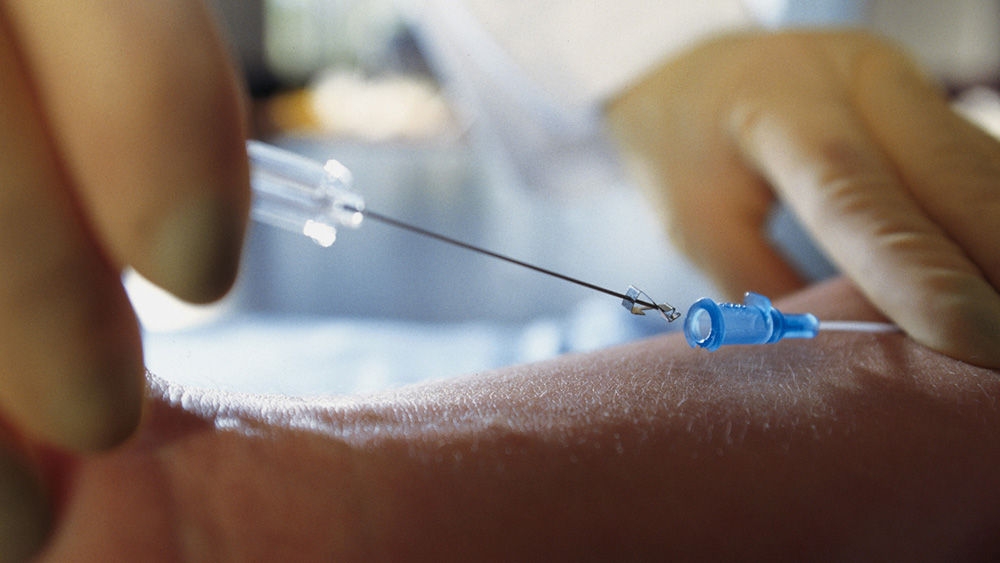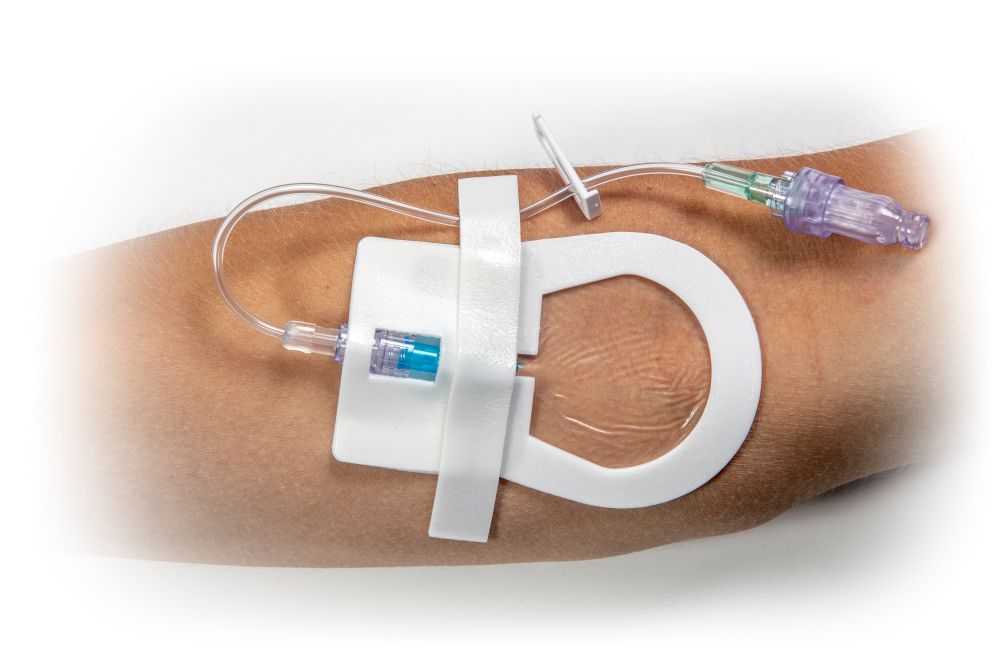No content results match your keyword.
Content
You have successfully logged out.
Vascular Access Management
Intravenous infusion therapies start with vascular access. At B. Braun, we developed the Introcan Safety® Family of Passive Safety IV Catheters with the guiding principle of making the job of IV access safe for clinicians.1
Around
35- 0%
Average failure rate of peripheral IV catheters2
In a survey, more than
0%
of nurses report being exposed to blood multiple times a month during an IV catheter insertion.3
Peripheral IV catheters are the most common invasive procedure performed in hospitals.4 Although a routine hospital procedure, the placement of PIVCs remains a complex task that is associated with complications and risks for both patients and medical staff, such as:
Because patient access is so common, PIVCs play a key role in improving the quality of infusion therapy. B. Braun peripheral IV catheters are designed to help prevent many of these risks and consequential costs.

Once vascular access is achieved, catheter maintenance and care can be vital to the survival of the line. Common vascular access complications like dislodegement, infiltration, and extravasation are preventable when proper measures are taken to care for a catheter.
Learn More
Our fully automatic passive safety IV catheters are designed to make access easy while helping to prevent accidental needlestick injuries and reducing the risk of bloodborne pathogen exposure.
/
The Clik-FIX All-in-One includes a securement device, transparent dressing, foam base pad and extra foam tape strip. The cushioned foam base pad helps to reduce the risk of pressure injuries.
/
CARESITE needleless connectors and extension sets are designed to help reduce catheter occlusions while preventing healthcare workers from accidental needlestick injuries.
/
As the clinician placing the IVs, you see first hand the pain that multiple sticks or IV complications can cause.
How B. Braun Supports Nurses:
Breadth of Portfolio: We have created a vast portfolio of various gauge sizes and lengths to provide so that nurses can have options when selecting the right device for their patient's needs.
Education: B. Braun eUniversity is an on-demand asynchronous learning platform with application and handling videos for our Introcan Safety product portfolio. It is available 24/7 so that nurses can refresh their product realted skills.
Clinical Thought Leaders: B. Braun Canada has partnered with key opinion leaders in the field of vascular access to provide additional clinical support for the latest practices and procedures in vascular access such as ultrasound guided peripheral IV insertions.
Administration is tasked with improving operational, financial and clinical outcomes. However, staff shortages and tightening budgets can limit what can feel accomplishable.
How B. Braun supports Administration:
Standardization: The Family of Introcan Safety IV Catheters can be used across the various departments of a hospital. Standardizing on one IV catheter without sacrificing specific clinical considerations can generate cost savings from volume discounts.
On-Demand Training: B. Braun eUniversity empowers your staff to stay up-to-date on their product knowledge in a fast-paced environment.
Longer Dwell Times: The Introcan Safety Deep Access product portfolio is designed to increase first stick success rates and last longer in the vein.5 These two combined benefits could lead to less restarts, which are costly to health systems.
Nurse Educators often deal with the stress of practice changes in the hospital. And current staff shortages means that you are planning educational resources for nurses with varying skills.
How B. Braun supports Nurse Educators:
Standardization: The Introcan Safety Family of IV Catheters has the same insertion technique for every device. No matter the gauge size or length. This means as patients and nursing staff move around the hospital units, everyone will be familiar with the vascular access device.
Education: We offer insertion guides in many formats so that nurses will always have access to the information they need for the best patient care. We also offer B. Braun eUniversity video library 24/7 for free to hospitals so that nurses can enhance their product knowledge at their own pace.
Materials Management has the dual task of supplying products that meet clinical needs while maintaining the hospital's operational budget.
How B. Braun supports Materials Management:
Standardization: The Introcan Safety product portfolio can harmonize and reduce the number of IV catheter SKUs used in your hospital. Without sacrificing clinical specificity, Introcan Safety can be used in multiple departments.
Reducing Waste: Introcan Safety is designed to promote first stick success. By reducing IV catheter restarts, your hospital could see cost savings.6 Introcan Safety also takes up less space in sharps containers,7 further adding to your hospitals cost savings.
You are commissioned to reduce healthcare-acquired infections and improving patient care in your hospital. As one of the most common invasive procedures in healthcare,6 safety in vascular access is a priority.
How B. Braun supports Infection Prevention:
Multi-Access Blood Control: Introcan Safety 2 and Introcan Safety 3 have a multi-access blood control septum that help reduce blood exposure to nurses and clincians.
Passive Safety Clip: All Introcan Safety catheters have a passive safety clip that automatically deploys during withdrawal is designed to protect against needlestick injuries.
Long Peripheral IV Catheters: Introcan Safety 2 Deep Access is a multi-access blood control long peripheral IV catheter for use with ultrasound guided insertions. This technique can help reduce the need to escalate patients to midlines or PICCs because of failed insertion attempts.
1. Tosini W, Ciotti C, Goyer F, Lolom I, L'Hériteau F, Abiteboul D, Pellissier G, Bouvet E. Needlestick injury rates according to different types of safety-engineered devices: results of a French multicenter study. Infect Control Hosp Epidemiol. 2010 Apr;31(4):402-7. doi: 10.1086/651301. PMID: 20175681.
2. Helm RE, Klausner JD, Klemperer JD, Flint LM, Huang E. Accepted but unacceptable: peripheral IV catheter failure. J Infus Nurs. 2015 May-Jun;38(3):189-203. doi: 10.1097/NAN.0000000000000100. PMID: 25871866.
3. Jagger J, Perry J, Parker G, Phillips EK. Nursing2011 survey results: Blood exposure risk during peripheral I.V. catheter insertion and removal. Nursing. 2011 Dec;41(12):45-9. doi: 10.1097/01.NURSE.0000407678.81635.62. PMID: 22089909.
4. Zingg W, Barton A, Bitmead J, Eggimann P, Pujol M, Simon A, Tatzel J. Best practice in the use of peripheral venous catheters: A scoping review and expert consensus. Infect Prev Pract. 2023 Feb 3;5(2):100271. doi: 10.1016/j.infpip.2023.100271. PMID: 36910422; PMCID: PMC9995289.
5. Bahl A, Hijazi M, Chen NW, Lachapelle-Clavette L, Price J. Ultralong Versus Standard Long Peripheral Intravenous Catheters: A Randomized Controlled Trial of Ultrasonographically Guided Catheter Survival. Ann Emerg Med. 2020 Aug;76(2):134-142. doi: 10.1016/j.annemergmed.2019.11.013. Epub 2020 Jan 16. PMID: 31955940.
6. Keleekai NL, Schuster CA, Murray CL, King MA, Stahl BR, Labrozzi LJ, Gallucci S, LeClair MW, Glover KR. Improving Nurses' Peripheral Intravenous Catheter Insertion Knowledge, Confidence, and Skills Using a Simulation-Based Blended Learning Program: A Randomized Trial. Simul Healthc. 2016 Dec;11(6):376-384. doi: 10.1097/SIH.0000000000000186. PMID: 27504890; PMCID: PMC5345884.
7. B. Braun Data on File.